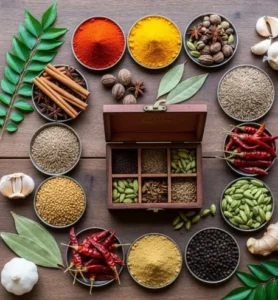Indian food is known the world over for its shading, taste and flavor. What makes Indian dishes one of a kind is the expansion of a few flavors. These flavors not just make for awesome parts while cooking – they accompany a large group of medical advantages as well. Here is a rundown of probably the most normally utilised Indian spices and the medical advantages they offer.

Cardamom
Cardamom develops generally in India, Malaysia and Ceylon. It has dependably been known for its stomach related properties. At the point when joined with ginger, cloves and cinnamon, it makes a delightful mixture, which is useful for your general wellbeing.
Turmeric
Turmeric is an exceptionally prominent flavor that is utilized broadly in Indian cooking. It gives brilliant yellow shading to the dishes and is subsequently nicknamed as “Indian saffron”. Turmeric has calming properties and was utilized by antiquated healers to treat an extensive variety of conditions.
Clove
This little bloom like zest has a great deal of employments. It is a typical fixing in cleansers, toothpastes and scents. Clove has been being used since the antiquated circumstances. Clove oil is exceptionally successful in regarding stomach conditions, for example, the runs, gas, and annoyed stomach. It additionally eases torment when connected topically.
Coriander
Coriander is accepted to have been being used for as long as 7000 years for cooking and mending. The new leaves are known as cilantro and the seeds are sold entire or ground. Like other Indian flavors, coriander has calming properties and aides in processing. The cancer prevention agents introduce in the zest is useful in assuaging oxidative worry in those harassed with diabetes.
Asafetida
A notable seasoning operator, asafetida loans a sharp taste to the dishes. It offers a few medical advantages. It helps in processing and furthermore helps in the treatment of a wide cluster of respiratory issue, for example, asthma, hack, and bronchitis. It is likewise known to help reduce agonizing and exorbitant monthly cycle in ladies.
Saffron
It is a profoundly prized outlandish zest prestigious for its shading, enhance and multitudinous medical advantages generally alluded to as “zest of wealth”. Saffron is a decent wellspring of potassium, manganese, calcium, press, selenium, zinc and manganese.
Cumin seeds
They are broadly developed in India and as often as possible utilized as a part of cooking. Cumin helps in processing because of the nearness of a fragrant compound called cuminaldehyde. Cumin likewise creates a compound called thymol that secretes different acids/chemicals that guide absorption. Cumin is likewise known to alleviate respiratory conditions, pallor, skin issue and tumor.
The logical premise of “Ayurveda” which is an antiquated branch of drug is the utilization of normal fixings to feed, fortify and mend the body. ORAC (Oxygen radical absorbance limit) is a strategy for estimating cancer prevention agent properties in natural examples. Research has demonstrated that spices in India have the most astounding ORAC esteems which empower them to kill free radicals, increment digestion and give supplement thick an incentive to the nourishment.
Seasonal Spice Benefits
Indian spices are not only flavorful but also work differently across seasons to support overall health. What to use during winter, summer & monsoon often depends on the body’s needs and climate conditions. Warming spices like clove, cinnamon, and black pepper help with circulation and immunity in the winter months. In the summer months, cooling spices like fennel seeds, or coriander help to keep you hydrated and aid digestion. During the monsoon, immunity-boosting spices such as turmeric, ginger, and asafetida provide protection against infections and healthy gut function.
Spices and Immunity
Proper immune support is one of the most valued and incredible qualities of Indian spices. For thousands of years, Ayurveda has advocated for the use of everyday spices not only for flavour but also as natural shields from illness. Spices such as turmeric, black pepper, ginger, garlic, and cinnamon have beneficial antibacterial, antiviral, and anti inflammatory functions.
To take turmeric for example, its active compound curcumin has the power to combat inflammation and infections, while black pepper enriches your spices by helping nutrients assimilate better, making it a “friend” spice. Ginger is a great spice for treating colds and coughs and is clarified by western science; cinnamon regulates blood sugar and increases the body’s ability to resist flu during the seasons when flu are more prevalent.
For instance, most Indian households will make immunity drinks called (described below) “kadha” or the traditional use of a herbal decoction. These recipes are as valid today as they were before modern science emerged to confirm their use in community health and immunity through prevention of common infections.
FAQs
Q1. What are the most commonly used Indian spices and their benefits?
Common Indian spices include turmeric, cardamom, clove, coriander, saffron, cumin seeds, and asafetida. They are known for digestive, anti-inflammatory, and antioxidant benefits.
Q2. How does cardamom benefit digestion?
Cardamom helps improve digestion, reduces bloating, and when combined with ginger, cloves, and cinnamon, supports overall gut health. Many green cardamom manufacturers highlight these digestive benefits when supplying high-quality cardamom for culinary and wellness use.
Q3. What are the health benefits of cloves?
Cloves have antioxidant, anti-inflammatory, and digestive benefits. Clove oil is used for stomach issues like gas and diarrhea, and it also helps relieve toothache when applied topically.
Q4. What is asafetida used for in Indian cooking and health?
Asafetida adds a sharp flavor to dishes and helps with digestion, asthma, cough, bronchitis, and even menstrual pain relief.
Q5. Do Indian spices really have high antioxidant properties?
Yes, Indian spices have high ORAC (Oxygen Radical Absorbance Capacity) values, which means they help neutralize free radicals, boost metabolism, and provide nutrient-dense health support.


